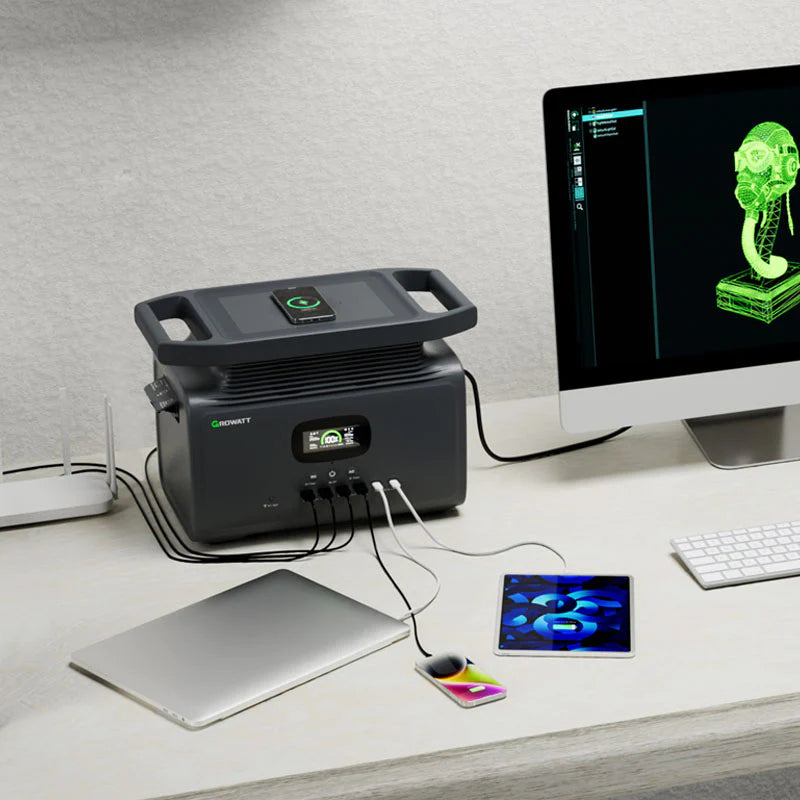With the development of a more modern, connected world, portable chargers are becoming significant components to help us keep our devices powered up and ready to roll. These compact, rechargeable batteries provide an easy way to charge your smartphone, tablet, or other USB-powered gadgets whenever you're on the go and far from a wall outlet.

The beauty of portable chargers lies in their versatility and portability. Whether going on a trip, hiking, to a conference, or just an outdoors day, these little devices keep your device never out of life. They will get rid of you from that frustration of a drained device and keep you connected, productive, and entertained wherever life may take you.
However, with the great usefulness of portable chargers comes knowing how to go about charging and maintenance. Not only does improper charging diminish the service life for your portable charger, but it can also be quite dangerous. Following the right techniques and guidelines ensures that a portable charger remains sure and durable against any power need.
The Most Important Rules for Charging a Portable Charger
First and foremost, using the right charger will go a long way in elongating its life and, most importantly, ensuring safety. A charger from the manufacturer is genuine and will work for your device since it has been made to do so. The chargers provided by third parties may not provide the correct voltage or amperage, hence likely causing some damages to your portable charger's battery or some of the internal parts.
Overcharging is the other common thing that can considerably shorten the life of your portable charger. The temptation to charge overnight might be very convenient, but overcharging will degrade the battery a lot quicker than it's supposed to. While most new portable chargers have safeguards built-in against overcharging, it's better not to let the device stay plugged in once it reaches full charge. Try to charge your portable charger only when necessary and unplug the power source once it has reached its 100 percent capacity.
How to Charge a Power Bank Portable Charger?
The process of charging a portable power bank, in general, is simple. However, there is a proper way of doing things so that your device can be long-lived and safe. First, ensure you read the user manual comprehensively in advance, as each different power bank may have particular instructions from its manufacturer.

First, you have to find the charger cable that came with your power bank. You will be required to use the charging cable that initially came with the power bank instead of other third-party cables; otherwise, they may just result in your device not being supported or damaged.
Next, plug the other end of the cable into the appropriate charging port on your power bank. For most of the modern power banks, this would be a micro-USB or USB-C port for charging, while older ones may use some sort of proprietary charging port. Once it's connected, plug the other end into a good power source, such as a wall outlet or into a USB port on your computer.
Now it is time you allow your power bank to get charged. It takes anywhere from two to eight hours depending on the capacity of your gadget and the source you are using. Well, one should show patience and wait for its full charge before unplugging it.
While charging your power bank, you will get indications of onscreen display or LED lights while charging. Even larger power banks indicate audio notification in case of completion of the charging process.
When your power bank is fully charged, it needs to be unplugged from the charger and kept appropriately. Overcharging can damage or reduce battery life if left plugged once charging is complete.
How to Know If Your Portable Charger Is Charging
One of the most common questions when it deals with the charging of a portable charger is how they actually show that a portable charger is charging. Fortunately, most portable chargers have indicators that easily help in showing when they are receiving power.
The most common method through which people know their portable charger is charging includes LED indicator lights. These small lights normally come within the casing on either the side or the front and light up once the charger is plugged in and charging. To say this, a solid red light may mean it is charging, while a solid green light may be for fully charged.
In fact, some of the high-end portable chargers include an LED display screen that shows the particular percentage of charge remaining within the battery. These screens can be pretty helpful for keeping track of your charger's battery level and ensuring you head out the door with a full charge.

Other portable chargers use sound to develop indicators when the charger is charging or full. Simple beeping or chime sounds may be set to play upon first plug-in or when it reaches full capacity.
Whatever type of indicator is present in your portable charger, it always does good to consider the user manual or manufacturer's website for specification data about how to interpret various lights, sounds, or displays. If ever there is a doubt with regard to your charger charging properly, it is always better to be safe than sorry, therefore, try using a different power source or contact the manufacturer for any kind of assistance.
Frequently Asked Questions
How to charge a power bank for the first time?
Charging a new power bank for the first time is a straightforward process, but there are a few important steps to follow. First, locate the charging cable that came with your power bank and plug it into the appropriate input port. Next, connect the other end of the cable to a power source, such as a USB port on your computer or a wall charger. Most power banks will have LED indicator lights that will illuminate or begin blinking to indicate that charging has started.
It's generally recommended to fully charge a new power bank before using it for the first time. This initial charge can take anywhere from 2-8 hours, depending on the capacity of the power bank and the output of the power source. Be patient and allow the power bank to charge completely before unplugging it. Once fully charged, the LED indicators will typically show a solid light or turn off entirely.
How to maintain a portable charger's battery life?
Proper maintenance is key to ensuring your portable charger's battery lasts as long as possible. Here are some tips:
-
Avoid extreme temperatures: Heat and cold can degrade battery performance over time. Store your charger in a cool, dry place when not in use.
-
Don't overcharge: Once your charger is fully charged, unplug it from the power source. Leaving it plugged in and charging continuously can damage the battery.
-
Discharge it periodically: If you plan on storing your charger for an extended period, discharge it to around 50% capacity before putting it away. This helps prevent over-discharging, which can also harm the battery.
-
Use it regularly: Portable chargers work best when they're cycled regularly. Try to use and recharge your charger every few months to keep the battery healthy.
-
Replace when necessary: All batteries degrade over time. If you notice your charger's capacity diminishing significantly, it may be time to replace it.
Common portable charger charging issues and solutions
Even with proper care, you may encounter some common charging issues with your portable charger. Here are a few problems and potential solutions:
-
Not charging at all: Check that the charging cable is securely connected to both the charger and power source. Try a different cable or power source to rule out a faulty connection.
-
Charging slowly: Slow charging can be caused by using a low-output power source, like a computer USB port. Switch to a wall charger or high-output power source for faster charging.
-
Stops charging before full: This could indicate a damaged battery or charging circuit. Try fully discharging the charger and then recharging it. If the issue persists, the charger may need to be replaced.
-
Gets very hot while charging: Excessive heat is a sign of a potential safety issue. Stop charging immediately and allow the charger to cool down. If it continues to overheat, discontinue use and replace the charger.
Remember, if you encounter persistent or concerning issues with your portable charger, it's best to consult the manufacturer or seek professional assistance.
Choosing the Right Portable Charger
Now, in terms of selecting the portable charger, it is about a set of small factors. Of all those, you will very much want to take a look at the battery capacity. This will tell you how many times you'll be able to charge your devices all the way before having to recharge the portable charger itself. In general, the higher the mAh rating of the model, the more charges you will have at your disposal.
Another major deciding factor is charging speed. Some portable chargers feature fast-charging technologies such as Quick Charge or USB Power Delivery that can dramatically cut down the time it takes to top up your devices. If you are one of those mobile people, this may be a game-changer.
Moreover, safety has to be ensured when selecting a portable charger. Find those with approval from organizations like UL (Underwriters Laboratories) or Conformité Européenne. Such certification denotes that the charger has been through extremely stern tests to meet minimum standards of safety.
Finally, in the case of portable chargers, it is better to stick with known brands. Yes, there are quite a few budget options available, but they may not always guarantee precisely the same quality and safety as do more upscale brands. Do a bit of research and read some reviews to inform yourself about what is best for you.
Portable Charger Safety Tips
Portable chargers are swell little powerhouses, but with great power comes great responsibility. One of the key safety precautions involves never using a damaged or fake charger. Bad wiring or low-quality components inside may cause a fire hazard or even an explosion. Always use the charger that originally came with your device or a reputable third-party option from a trusted brand.
Another safety precaution involves keeping your portable charger away from anything that might catch fire while it is in use. Though the temperature produced during charging is really minimal, combustive materials like paper, fabrics, and chemicals can easily catch fire at small heat rates. Keep your charging area free from clutter and anything that might catch fire.
Finally, stop charging your portable charger once it reaches a full charge. Overcharging will weaken the battery over time and can cause overheating, even a fire, in extreme cases. Even though most modern chargers have safety features that avoid overcharging, it is always good to unplug them once full.
Conclusion
Portable chargers have become a necessary element in our mobile lifestyles, always keeping our gadgets charged up and connected in those places where conventional sources of power are not available. To keep this particular travel buddy with you for a very long period of time, though, it pays to know how to charge and maintain it properly.
To this end, following this guidebook will assist you in expanding the life of the portable charger while trying to reduce damage and other safety risks. Always make use of the recommended charger and cable to avoid the overcharging of the device, store your device correctly when not in use.
As such, a well-cared-for portable charger is one that not only gives peace of mind but also ensures that you would never face such a point in life when you need your device and find its batteries completely dead. Yes, enjoy mobile power with convenience, yet be responsibly careful with its longevity via a good habit of charging it.






